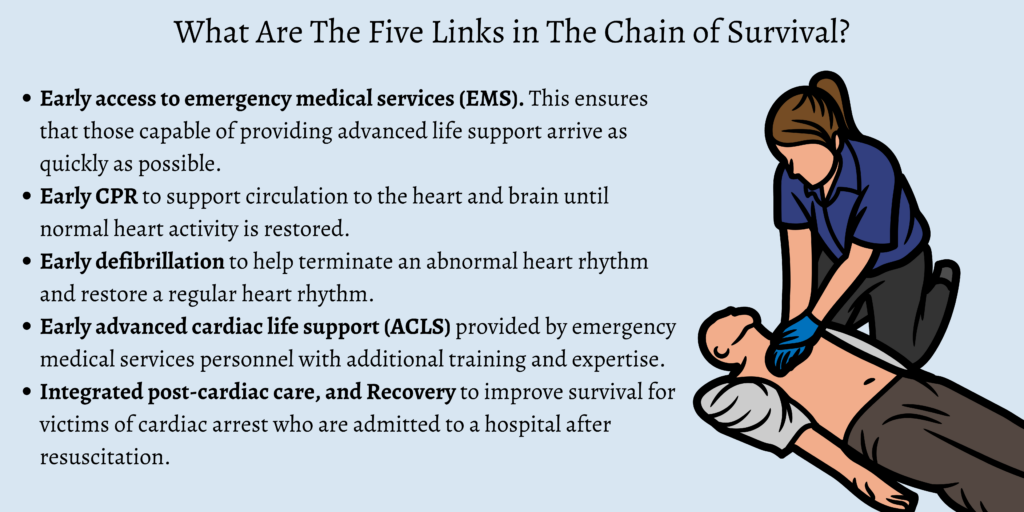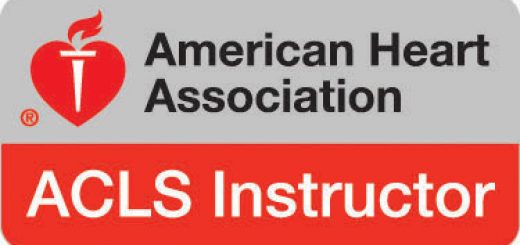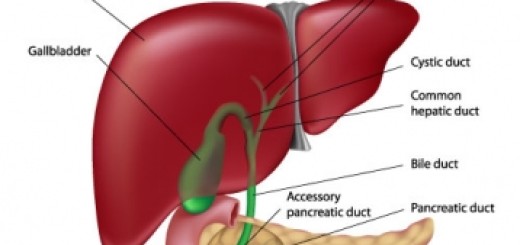What Are The Five Links in The Chain of Survival?
The American Heart Association (AHA) Chain of Survival describes the critical actions required to treat victims of sudden cardiac arrest (SCA). When all links of the Chain of Survival are completed this provides the best possible chance of survival from a cardiac arrest.
If care is not provided within the first 10 minutes following an SCA, survival is unlikely. And unfortunately, most cardiac arrest patients die before they reach the hospital.
However, this doesn’t need to be the case. The majority of SCA survivors receive help from bystanders, and every moment counts. So, it’s essential that members of the general public familiarize themselves with the Chain of Survival metaphor.
The Chain of Survival was first published in the Journal of Emergency Medical Services in 1989. Back then, it consisted of four steps: early access to medical care, early CPR, early defibrillation, and early advanced cardiac life support.
Since then, the American Heart Association has added two further steps to the chain. These are post-cardiac arrest care and physical and emotional recovery and rehabilitation. Together, these create what is now known as the six links of the Chain of Survival.
This simple series of actions is designed to educate members of the public and arm them with the confidence and knowledge to respond to an SCA emergency quickly and effectively.
The first three links are particularly vital, as these can be performed by any bystander. Yet, the subsequent three steps are carried out by trained medics.
- Early access to emergency medical services (EMS). This ensures that those capable of providing advanced life support arrive as quickly as possible.
- Early CPR to support circulation to the heart and brain until normal heart activity is restored.
- Early defibrillation: to help terminate an abnormal heart rhythm and restore a regular heart rhythm.
- Early advanced cardiac life support (ACLS) provided by emergency medical services personnel with additional training and expertise.
- Integrated post-cardiac care, and Recovery to improve survival for victims of cardiac arrest who are admitted to a hospital after resuscitation.
Now, let’s examine each link in the chain in more detail:
Early Access to Emergency Medical Services (EMS)
The first link in the treatment of any emergency is to recognize that an emergency exists. As soon as this is established, phone the appropriate emergency response number immediately.
Early warning signs of cardiac arrest include pain in the chest, neck, back, arms, shoulder, and jaw, as well as nausea and vomiting, lightheadedness, and shortness of breath.
If the incident occurs in a setting such as a workplace, the next step is to trigger the internal alert system. This notifies any trained medics or first aiders on site, prompting them to attend the scene as quickly as possible.
If other bystanders are present, they should locate the nearest automated external defibrillator (AED) and bring it to the patient immediately.
Early CPR
The second link is early cardiopulmonary resuscitation (CPR). This is the delivery of chest compressions and rescue breaths to a victim who is not breathing normally.
CPR is the critical link that buys time between the first link (early access) and the third link (early defibrillation). CPR supports the delivery of oxygen to the brain and heart until defibrillation or other advanced care can restore normal heart action.
Bystanders should begin CPR immediately after a casualty loses consciousness. Less than 40% of people who suffer SCA receive CPR before the emergency services arrive. This has a devastating impact on a person’s chances of survival.
Many bystanders are reluctant to provide CPR because they are unsure if an unresponsive casualty is suffering a genuine cardiac arrest. But the American Heart Association emphasizes the need for hands-only CPR by lay rescuers in any suspected cardiac arrest. This is because the overall risk of harm to a person whose heart is still beating is low.
To learn more about how to administer life saving CPR, read our in-depth guide here.
Early Defibrillation
The third link is early defibrillation with an automated external defibrillator (AED).
Most adult victims of a witnessed sudden cardiac arrest are in ventricular fibrillation (VF). VF is an abnormal and chaotic heart rhythm that prevents the heart from pumping blood.
The treatment for VF is an electrical shock to clear the chaotic electrical activity and restart the heart back into a regular beat. This is known as defibrillation. With each minute that defibrillation is delayed, the victim’s chance of survival falls by approximately 7% to 10%.
But rapid defibrillation provided by bystanders in an out-of-hospital setting can increase survival rates by up to 30%. This is why early defibrillation is considered to be the single most critical link in the entire Chain of Survival.
Unfortunately, AEDs are not readily available everywhere. In this case, it’s essential to continue with CPR until the emergency services arrive. But thankfully, AEDs are becoming more common in public places, such as schools, offices, shopping malls, and sports centers. You don’t need any special training to use an AED. A prerecorded audio guides the bystander through the defibrillation process step by step.
That being said, it’s helpful for first aiders to familiarize themselves with these machines and how to use them. For more information, read our pad placement guide here.
Early advanced cardiac life support (ACLS)
The fourth link is the arrival of trained EMS personnel to provide advanced cardiac life support (ACLS) outside the hospital. This is why it’s essential to initiate step one of the Chain of Survival, calling 911 immediately when a cardiac arrest is suspected.
Paramedics trained in ACLS can administer life-saving medications while monitoring the patient’s heart to identify issues. They may also use transcutaneous pacing to temporarily pace the patient’s heart until they arrive at the hospital.
These specially trained emergency responders may also attach an electrocardiogram to the patient’s chest. The findings are recorded and sent to the hospital before the patient arrives. This provides crucial information to the receiving medics, which can greatly increase the chances of survival.
Integrated Post-Cardiac Care, and Recovery
The fifth link is the integrated in-hospital care management that a person will receive if they’re resuscitated. A multidisciplinary team of specialists will administer a wide range of treatments and monitoring. These interventions may include (TTM) Targeted Temperature Management (also known as induced hypothermia) and ventilation optimization to maintain proper arterial oxygen saturation and avoid hypoxia and hyperoxia.
The recovery and rehabilitation, which begins as soon as a patient wakes up after surviving a cardiac arrest. The American Heart Association added the Recovery link in October 2020, citing the importance of continuous physical and emotional support for a patient after what is undoubtedly a life-changing event.
Recovery begins in the hospital, where a patient receives ongoing treatment and surveillance. The AHA recommends all cardiac arrest survivors undergo a thorough assessment of their rehabilitation needs before leaving the hospital. Caregivers at home should also be involved in the discharge planning process.
Conclusion
The Chain of Survival has helped countless bystanders to administer lifesaving care for victims of sudden cardiac arrest. However, much more work needs to be done to educate the public about this crucial series of actions.
So, be sure to familiarize yourself with the six links in the Chain of Survival, and share this guide with your friends and family, so that they too can know what to do in the event of a cardiac arrest emergency.






